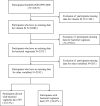Association between serum vitamin E and bacterial vaginitis in women: a cross-sectional study
- PMID: 38824532
- PMCID: PMC11143631
- DOI: 10.1186/s12905-024-03065-4
Association between serum vitamin E and bacterial vaginitis in women: a cross-sectional study
Abstract
Introduction: Bacterial vaginitis (BV) is a common vaginal disease. Vitamin E has been shown to reduce BV by enhancing immune function, but no studies have analyzed the relationship between vitamin E and BV at different BMIs and ages.
Method: This study used 2242 participants from four cycles of NHANES 1999-2006 in American. Participants' vitamin E levels were divided into four groups, and analyses such as study population description, stratified analysis, multiple logistic regression analysis, and curve fitting were performed. To perform data processing, the researchers used the statistical package R (The R Foundation; http://www.r-project.org ; version 3.6.3) and Empower Stats software ( www.empowerstats.net , X&Y solutions, Inc. Boston, Massachusetts).
Result: The concentrations of serum vitamin E were negatively correlated with the risk of BV, especially when vitamin E were at 1198-5459ug/dL with (OR = -0.443, 95%CI = 0.447-0.923, P = 0.032) or without (OR = -0.521, 95%CI = 0.421-0.837, P = 0.006) adjustment for variables. At the same time, at lower levels, there was no significant association. Vitamin E supplementation may significantly reduce the risk of BV (p < 0.001). In addition, the risk of having BV decreased and then increased with increasing vitamin E concentrations at high BMI levels (p < 0.01).
Conclusion: Vitamin E at moderate to high concentrations may significantly reduce BV risk, says the study, providing clinical evidence for the prevention and the treatment of BV.
Keywords: Bacterial vaginitis; Cross-sectional study; Female diseases; National Health and Nutrition Examination Survey; Vitamin E.
© 2024. The Author(s).
Conflict of interest statement
The authors declare no competing interests.
Figures




Similar articles
-
Negative associations between folate and bacterial vaginosis in the NHANES 2001 to 2004.BMC Infect Dis. 2023 Jul 19;23(1):483. doi: 10.1186/s12879-023-08318-5. BMC Infect Dis. 2023. PMID: 37468843 Free PMC article.
-
Association between serum carotenoids and bacterial vaginosis infection among American women.BMC Infect Dis. 2024 Jan 2;24(1):20. doi: 10.1186/s12879-023-08908-3. BMC Infect Dis. 2024. PMID: 38166673 Free PMC article.
-
Association between heavy metal exposure and bacterial vaginosis: A cross-sectional study.PLoS One. 2025 Jan 8;20(1):e0316927. doi: 10.1371/journal.pone.0316927. eCollection 2025. PLoS One. 2025. PMID: 39774460 Free PMC article.
-
Bacterial vaginosis, vulvovaginal candidiasis and trichomonal vaginitis among reproductive-aged women seeking primary healthcare in Sana'a city, Yemen.BMC Infect Dis. 2019 Oct 22;19(1):879. doi: 10.1186/s12879-019-4549-3. BMC Infect Dis. 2019. PMID: 31640583 Free PMC article.
-
The Association Between Vaginal Microbiota Dysbiosis, Bacterial Vaginosis, and Aerobic Vaginitis, and Adverse Pregnancy Outcomes of Women Living in Sub-Saharan Africa: A Systematic Review.Front Public Health. 2020 Dec 10;8:567885. doi: 10.3389/fpubh.2020.567885. eCollection 2020. Front Public Health. 2020. PMID: 33363078 Free PMC article.
Cited by
-
Association of physical activity during pregnancy with labor and delivery in nulliparous patients.Eur J Obstet Gynecol Reprod Biol X. 2024 Dec 24;25:100361. doi: 10.1016/j.eurox.2024.100361. eCollection 2025 Mar. Eur J Obstet Gynecol Reprod Biol X. 2024. PMID: 39834627 Free PMC article.
-
Association between remnant cholesterol (RC) and endometriosis: a cross-sectional study based on NHANES data.Lipids Health Dis. 2025 Jan 4;24(1):2. doi: 10.1186/s12944-024-02422-4. Lipids Health Dis. 2025. PMID: 39754185 Free PMC article.
-
The association between global and prime diet quality scores and the risk of bacterial vaginosis: a secondary analysis of case-control study.J Health Popul Nutr. 2025 Feb 28;44(1):58. doi: 10.1186/s41043-025-00800-x. J Health Popul Nutr. 2025. PMID: 40022275 Free PMC article.
References
-
- Bautista CT, Wurapa E, Sateren WB, Morris S, Hollingsworth B, Sanchez JL. Bacterial vaginosis: a synthesis of the literature on etiology, prevalence, risk factors, and relationship with chlamydia and gonorrhea infections. Mil Med Res. 2016;13(3):4. doi: 10.1186/s40779-016-0074-5. - DOI - PMC - PubMed
-
- Schwebke JR, Richey CM, Weiss2 HL. Correlation of behaviors with microbiological changes in vaginal flora. J Infect Dis. 1999;180(5):1632–6. 10.1086/315065. PMID: 10515826. - PubMed
MeSH terms
Substances
LinkOut - more resources
Full Text Sources
Medical

